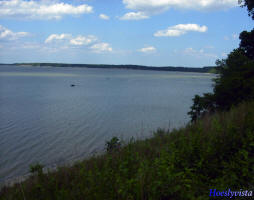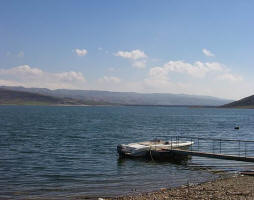 Green Morocco Plan Focuses On Sustainable Agriculture
Green Morocco Plan Focuses On Sustainable Agriculture
Crop supplies are considered to be a major component of Moroccan food security. They mainly rely on rainfall, which fluctuates sharply from year to year, thus affecting the level of agricultural production. Irrigation is only available to approximately 16% of arable lands, resulting in poor resilience in dealing with climatic risks, as well as difficulty in improving crop yields. Annual rainfall averages around 365 millimeters per year, ranging from as low as 198 millimeters recorded in the 1994-1995 season, to a maximum of 610 millimeters recorded in the 2009-2010 season. Rainfall levels fluctuate between seasons and fall below the average in most days of the year. The highest precipitation levels are recorded between October and April, which is a short window for crop growth.
Like most countries of the Mediterranean basin, Morocco’s agriculture primarily produces grains and beans. In arid areas, grains are grown on fallow lands, a small percentage of which is used to sow spring crops. In addition, olive trees cover approximately 980,000 hectares [2.4 million acres] of land, or 65% of the country’s tree groves.
On average, agriculture contributed to 18% of total GDP in the period extending from 1980 to 2010 (at prevailing prices), reaching a maximum of 23.3% in 1991 and a minimum of 13.3% in 2000. However, the contribution of agricultural output to GDP has been steadily declining since the early 1990s, reaching 16% during the period extending from 2000 to 2010. Agriculture, including fisheries, is considered to be the main labor employer (38% of the total national labor force and 75% of the rural workforce). The agricultural sector also contributes to reducing the mass exodus from rural areas, while bolstering social and political stability.
Winter grains such as soft wheat, hard wheat and barley account for 47% of agricultural added value, considering that they cover most arable lands (5.1 million hectares [12.6 million acres] on average). Livestock herding is the second most important contributor to agricultural GDP, with a 31% share. It is closely related to grain production. During dry seasons, the contribution of livestock herding increases in relation to other activities. It reached 38% in 1981, 39% in 1995 and 42% in 2000, attesting to its role in managing the climatic risks that farmers face.
Agricultural GDP, except for fisheries, is highly dependent on the weather. As a result, and considering the importance of the agricultural sector, any shortage or excess rainfall has an immediate effect on the economy as a whole. Weather also affects grain imports, with the import to production ratio varying between 15% (in 1994-1995 after the excellent harvest of 1993-1994) to 244% (in 2000-2001 after the drought of 1999-2000).
The production of main crops in irrigated lands is witnessing a marked improvement as a result of the increased use of farming inputs. In rain-fed areas, however, production continues to develop haphazardly, in conjunction with climatic conditions. The correlation between main crop yields and rainfall during harvest indicates that efforts expended thus far have had limited effects on production in rain-fed lands in the medium term, despite the important rise in yield research. The fact is that improving the productivity of rain-fed lands is difficult and requires drastic measures to adapt to aberrant and dry climatic conditions, particularly through the use of qualitative technologies available in Morocco, the training of farmers and the development of agro-meteorological services.
Reducing weather-related risks to agriculture
The Moroccan government’s measures to prepare for and respond to climatic risks were aimed at reducing the effects of drought and protect crop yields. They included structural measures (dams, irrigation systems, land use strategies and others), as well as non-structural measures (adaptive measures, drought damage insurance and solidarity funds). They can be summarized as follows:
- Developing infrastructure for water storage and irrigation water distribution
- Protecting upstream water resources
- Expanding irrigated areas
- Improving the efficiency of irrigation water usage
- Improving crop yields through the development of agricultural inputs (grains and approved fertilizers)
- Exploiting land resources to the maximum
- Using non-conventional water sources
- Adapting to climate change through the use of water conservation technologies
- Agricultural insurance against climate risks
Green Morocco Plan
In 2008, the Moroccan government adopted a strategy to drive and reform the agricultural sector, promote the integration of agriculture into international markets and help agriculture achieve sustainable growth. The strategy was called the Green Morocco Plan. Its implementation relies on two main pillars and a variety of intersecting programs. The first pillar relates to high-yield, intensive and market-related agriculture. The second relates to bolstering the position of small farmers through the proper promotion of crop yield growth and encouraging a shift toward crops that are better adapted to environmental conditions and market demand. The intersecting programs involve water conservation, land ownership and the mobilization of investments. In total, the Green Morocco Plan is comprised of 1,500 projects requiring, until 2020, more than $10 billion to implement.
Following is a summary of select programs being implemented under the Green Morocco Plan to improve food productivity and security in light of climatic changes:
The National Program for Irrigation Water Conservation: 77% of Morocco’s irrigated lands still receive water through surface irrigation methods. This program aims at conserving irrigation water by switching from surface to drip irrigation over a land area of approximately 550,000 hectares [1.36 million acres] by 2020, at a cost of $4.5 billion. Up until 2012, 333,000 hectares [823,000 acres] had been converted, while 700,000 hectares [1.7 million acres] are expected to be dependent on drip irrigation once the program is completed. In order to improve water conservation, the government is also subsidizing the cost of farm equipment needed for drip irrigation and providing crop seeds and seedlings adapted for such use.
Integrating climate change into the Green Morocco Plan: Climate change will reduce main crop yields and increase agricultural production fluctuations. As a result, the Green Morocco Plan has launched a variety of programs in order to adapt to climate change. The program aims at integrating climate change into the implementation of the plan (2011-2015) to improve overall adaptation to climate change in five regions of Morocco. The key technologies to be adopted on a wide scale include soil-protection measures, such as no-till farming, the use of authorized high-yield drought-resistant crops and crop rotation through the planting of leguminous or oil seed crops after each grain harvest. The program targets 900 small-scale farmers in these regions, and has been presented as an example of a success story at the Conference of Parties to the Convention on Climate Change (COP18) in Doha.
The program to shift from grains to fruit trees: the aim of this program is to plant 1.1 million hectares [2.7 million acres] of land unsuited for grain crops with fruit trees, particularly olive trees. Land-use suitability maps are used to choose the areas to be converted. The program focuses on land that is barren and degraded in order to encourage greater conservation of soil and water. Small-scale farmers will be organized into cooperatives and groups having shared economic interests, in order to bolster their relationship with and entry into markets, as well as for them to benefit to the maximum from their products’ added value.
Agricultural insurance: The Climatic Disaster Insurance Program was started by the Ministry of Agriculture to replace the 1996 program to insure against drought. Its aim is to protect small-scale farmers from climatic risks, in particular by reducing weather-related risks on agriculture. It aims as well at promoting easy access to funding, increasing investments, improving crop yields, contributing in developing a high added-value, modern agricultural sector, bolstering solidarity and encouraging small-scale farmers.
| Contact information | n/a |
|---|---|
| News type | Inbrief |
| File link |
http://www.moroccotomorrow.org/green-morocco-plan-focuses-on-sustainable-agriculture/ |
| Source of information | Morocco Tomorrow |
| Keyword(s) | Sustainable Agriculture |
| Subject(s) | AGRICULTURE , METHTODOLOGY - STATISTICS - DECISION AID , POLICY-WATER POLICY AND WATER MANAGEMENT |
| Relation | http://www.emwis.net/countries/fol749974/country154256 |
| Geographical coverage | Morocco |
| News date | 28/11/2014 |
| Working language(s) | ENGLISH |
 you are not logged in
you are not logged in





